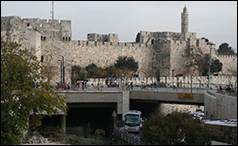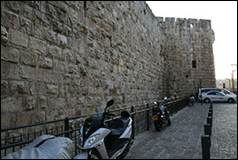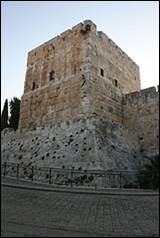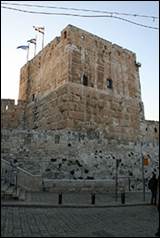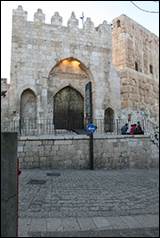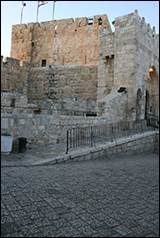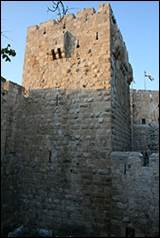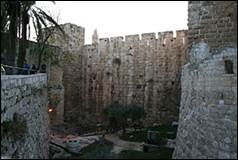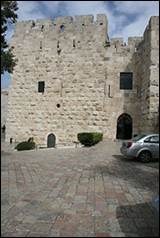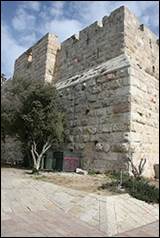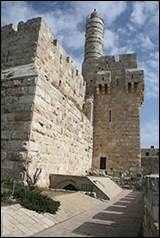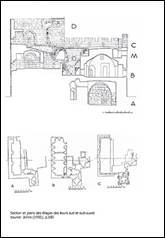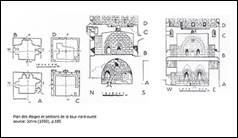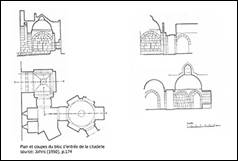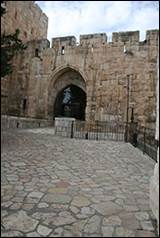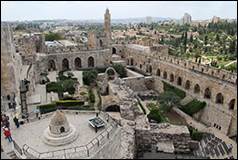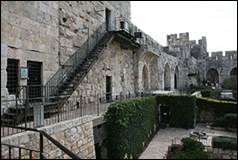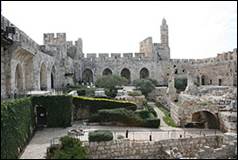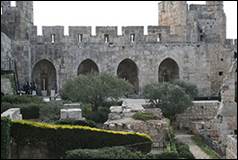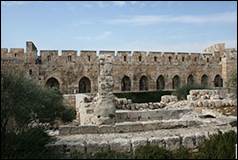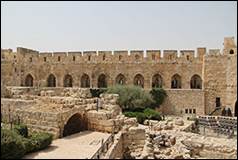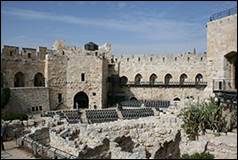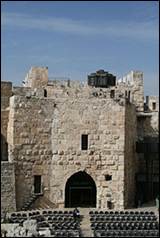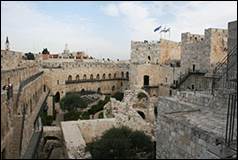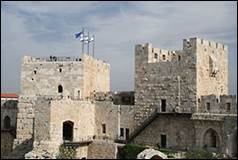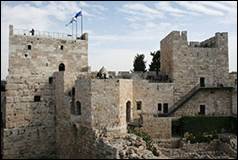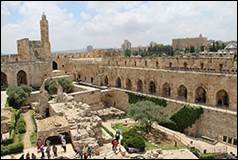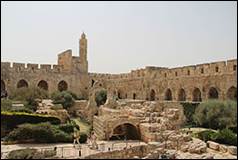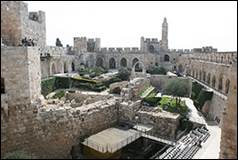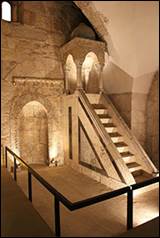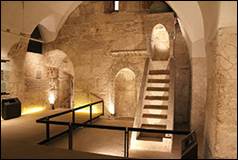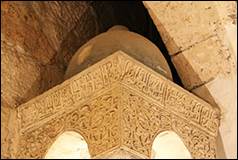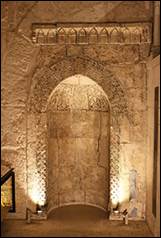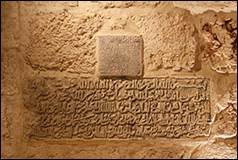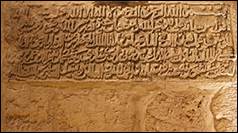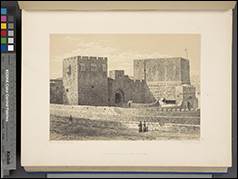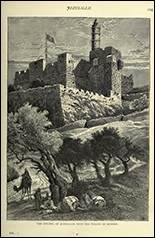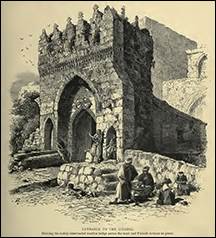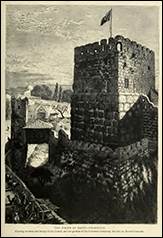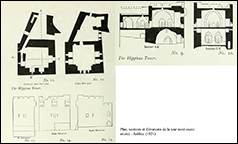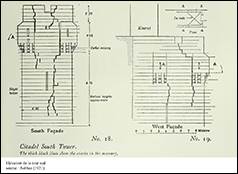Citadelle/Qal’at (n.d.)
Localisation : à l'ouest de la vieille ville, face à la Porte de Jaffa (B5.1).
Réf :
Amitai/Eitan (1970)
Berchem (1922), p.129-168
Bieberstein/Bloedhorn (1994) II, p.88-95
Busse (1994), p.155-159
Johns (1940)
Korn (2004), n°3
Meinecke (1992), 9C/8, 9C/9
Schick (1878), p.226-240
Wilson (1881), I, p.7-11
Berchem (1922), n°43, 44, 51
RCEA 3717, 5266, 5267
TEI, n°2982, 3143
Historique
La citadelle de Jérusalem a été largement reconstruite et étendue par les Croisés, elle est partiellement démantelée par les Ayyûbides, mais une inscription datée 610/1213 mentionne la construction d’une tour par le futur sultan al-Mu’azzam ‘Isâ (r.615/1218-624/1227).[1] Une autre inscription récemment découverte vers la tour nord-est (dite de David) mentionne des travaux du même sultan en 609/1212.[2]
En 710/1310-1311, le sultan al-Nâsir Muhammad (3e règne 30 ramadan 709/3.III.1310 – 21 dhu’l-hijja 741/7.VI.1341) fait entièrement restaurer le site, il confie les travaux au gouverneur de Safed Baktamur al-Jukandâr : la cour intérieure est réhaussée (ill.1, 17), une nouvelle entrée couronnée par un dôme hexagonal est créée à l’est (ill.1, 15), deux tours sont élevées au sud-est (ill.1, 11, 13) et au sud-ouest, la tour nord-ouest est élargie (ill.1, 14, 24) et une nouvelle tour carrée est ajoutée entre cette dernière et l’enceinte. L’avant mur ouest et est sont reconstruits et équipés d’une série d’archères, une mosquée est aménagée dans le bastion sud-ouest et sa poterne est supprimée. La mosquée abrite maintenant le Musée de la Citadelle (ill.1, 32-40).
Par la suite, la citadelle semble négligée et ne fera plus l’objet de réparations avant la conquête Ottomane.[3]
Epigraphie
609/1212. Inscription du sultan al-Mu’azzam ‘Isa, retrouvée vers la
tour nord-est (dite de David) en novembre 2020.[4]
Texte non disponible.
610/1213. Texte de construction 5 lignes (170x58), anciennement sur le
front ouest au sud de Bâb al-Khalîl/Porte de Jaffa, aujourd’hui au Musée de la
Citadelle (ill.37, 39).[5]
« Basmallâh. Coran IX, 11 ; XIV, 31. Cette
tour bénie a été refaite par ordre de notre maître al-Malik al-Mu’azzam Sharaf
al-dunya wa’l-dîn Abul-Muza[ffar] ‘Isa, fils d’al-Malik al-‘Adîl Saif al-Dîn
Abû Bakr Muhammad, fils d’Aiyûb, fils de Shadhî. Sa construction
fut dirigée par ‘Izz al-Dîn ‘Umar, fils de Yaghmûr, serviteur
d’(al-Malik) al-Mu’azzam, dans les mois de l’année 610 (1213), xxx, par
l’entreprise de l’avide de la miséricorde de Dieu, Khutlukh,
[serviteur d’](al-Malik) al-Mu’[azzam] ».
710/1310. Texte de restauration 3 lignes (100x40) sur le tympan de la
porte d’entrée.[6]
« Gloire à notre maître le très grand sultan al-Malik
al-Nâsir al-dunya wa’l-dîn Muhammad, fils du sultan al-Malik al-Mansûr Saif
al-dunya wa’l-dîn Qalâwûn, qu’Allâh glorifie sa victoire ! dans les mois
de l’année 710 (1310-11) ».
710/1310. Texte de construction de la mosquée 6 lignes (38x36) sur le mur
est, aujourd’hui au Musée de la Citadelle (ill.37, 38).[7]
« A contruit cette mosquée bénie notre maître
le sultan al-Malik al-Nâsir al-dunya wa’l-dîn Muhammad, fils du sultan al-Malik
al-Mansûr Saif al-dunya wa’l-dîn Qalâwûn, qu’Allâh glorifie sa victoire !
A la date de l’année 710 (1310-11) ».
« Coran III, 127 ».
Biblio complémentaire
Wightman (1993)
Geva (2000a), p.156-167
Hawari (2000), p.493-518
Sivan/Solar (2000), p.168-176
Boas (2001), p.73-79
Dotti (2007), n°4
Hawari (2007), p.194
Boas (2008), p.315-336
Leistikow (2008), p.326-336
Times of Israël 17/12/2020
|
|
|
|
|
|
|
1/ plan de la citadelle avec les vestiges antérieurs |
2/ la citadelle vue depuis l’ouest |
3/ la courtine nord et la tour nord-ouest |
4/ tour nord-est |
5/ tour nord-est |
|
|
|
|
|
|
|
6/ la tour porche avec l’inscription datée 938/1531 |
7/ vue de l’entrée |
8/ la tour est |
9/ la courtine sud-est et la tour sud-est |
10/ la façade sud de la tour nord-ouest avec la
poterne |
|
|
|
|
|
|
|
11/ la façade ouest de la tour sud-est |
12/ la tour sud-est et la tour sud |
13/ plans et sections des tours sud et sud-est |
14/ plans et sections de la tour nord-ouest |
15/ plan, élévation et sections de l’entrée |
|
|
|
|
|
|
|
16/ l’accès de la citadelle |
17/ vue de la cour vers le sud |
18/ le côté est de la cour vers le sud |
19/ vue de la cour vers le sud |
20/ archères de la courtine sud |
|
|
|
|
|
|
|
21/ le côté ouest de la cour |
22/ la courtine ouest |
23/ la tour nord-ouest et la courtine nord-ouest |
24/ la tour nord-ouest |
25/ vue de la cour vers l’ouest et le nord-ouest |
|
|
|
|
|
26/ le côté ouest et nord de la cour |
27/ les tours nord-est et est avec l’entrée donnant
sur la cour |
28/ les tours nord-est et est |
|
|
|
|
|
29/ la cour vers le sud et la courtine ouest |
30/ la cour vers la sud-ouest |
31/ la cour vers le sud et sud-est |
|
|
|
|
|
|
32/ le minbar et le mihrâb de la mosquée |
33/ le minbar et le mihrâb de la mosquée |
34/ la partie haute du minbar |
35/ l’inscription ottomane du minbar (Coran IX, 18) |
|
|
|
|
|
|
|
36/ le mihrâb de la salle de prière |
37/ les inscriptions de construction conservées au
Musée |
38/ l’inscription de construction datée 710/1310 |
39/ l’inscription de construction datée 610/1213 |
40/ plan et sections de la tour sud-ouest avec la
mosquée |
Documents anciens
Wilson (1881), I, p.7-11 . Visite entre octobre 1864 et fin mai 1865.
South of the Jaffa Gate is the Citadel, and beyond it are the barracks and the extensive gardens of the Armenian monastery. This portion of the western hill was covered in part, or perhaps entirely, by Herod's Palace, with its gardens, and by the three towers which adjoined it on the north. Josephus has left us a glowing account of the royal palace, which " was entirely surrounded by a wall thirty cubits high, with decorated towers at equal intervals, and contained enormous banqueting halls, besides numerous chambers, richly adorned."
The towers were built of blocks of white stone of great size, " so exactly joined together that each tower appeared to be one mass of rock;" and they played a prominent part during the memorable siege by the Romans. These towers were left standing by Titus, when he destroyed the city, to protect the legion left to garrison the place and prevent any insurrectionary movements on the part of the Jews.
Any remains which may now exist of Herod's Palace are buried beneath a mass of rubbish more than thirty feet deep ; but two at least of the towers, Phasaelus and Hippicus, can be recognised in the works of the modern Citadel. The Citadel, remodelled in the fourteenth century, and again repaired in the sixteenth century, consists of five square towers and other buildings, surrounded by a ditch. It has a commanding position, and before the introduction of fire-arms must have been of great strength. Even now the solid masonry of the lower portion would resist for some time any artillery that could be brought against it.
The Tower of David appears to be the oldest portion of the Citadel, and its dimensions and mode of construction agree well with those of the tower Phasaelus as. described by Josephus. The substructure consists of a solid masonry escarp, rising from the bottom of the ditch at an angle of about forty-five degrees, with a pathway, or chemin des rondes, round the top. Above this the tower rises in a solid mass for a height of twenty-nine feet, and then comes the superstructure. The escarp retains to some extent its original appearance, but time and hard treatment have worn away much of the finer work, and the repairs have been executed in the usual slovenly manner of the Turks. The old work, where it can be seen, is equal, if not superior, to the best specimens of masonry in the far-famed wall of the Temple Platform ; the faces of the stones are dressed with an astonishing degree of fineness, and the whole, when perfect, must have presented a smooth surface difficult to escalade, and, from the solidity of the mass, unassailable by the battering ram. The masonry of the solid tower is rougher ; the faces of the stones project, and they are pitted with a number of deep square holes which have long puzzled the antiquary. The superstructure contains several chambers, and a cistern for the collection of rain-water. In one of the rooms a " mihrab " marks the place where, according to Moslem tradition, David composed the Psalms, and another chamber is pointed out as the reception room of the same king. The Tower of David was the last place to yield when Jerusalem was captured by the
Crusaders ; and when the city walls were destroyed by the Moslems in the thirteenth century, it was for some reason—probably its solidity—spared, to come down to our own time as a fine example of the mural masonry of the Jews.
The remaining towers of the Citadel have suffered far more severely, from the battering they have undergone during numerous sieges, and without extensive excavation it would be impossible to determine their original form. The tower, however, which guards the Jaffa Gate, though its dimensions are somewhat smaller than those given by Josephus, is satisfactorily identified with the tower of Hippicus by the discovery of an aqueduct twelve feet below the level of the present conduit, which is probably that by which, according to the Jewish historian, water was brought into that building.
Within the Citadel there is ruin and rubbish everywhere ; without, in the moat, soldiers' gardens, beds of cactus or prickly pear, and filth of every possible description ; and on the ramparts a few old cannon, much dreaded by the artillerymen who have to fire them. The view from the top of David's Tower is extensive, embracing the whole town, the Mount of Olives, the Dead Sea, and the Mountains of Moab—a pleasant sight to feast the eyes upon
for half an hour before the sun goes down.
|
|
|
|
|
|
Vue de la Citadelle Source : Pierotti (1864) |
Vue de la Citadelle depuis le sud-ouest Source : Wilson (1881), I |
Vue de l’accès de la Citadelle Source : Wilson (1881), I |
Vue de la tour nord-ouest Source : Wilson (1881), I |
|
|
|
|
Plan, section et élévation de la tour nord-ouest Source : Ashbee (1921) |
Elévation de la tour sud Source : Ashbee (1921) |

